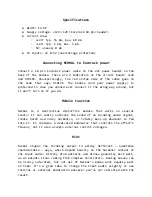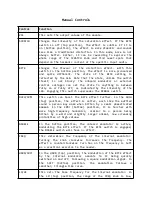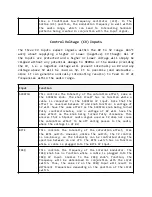
like a traditional low-frequency oscillator (LFO). In the
bottom (HI) position, the modulation frequency is well within
the
audio
range,
which
can
lead to interesting harmonic
patterns being created in conjunction with the input signal.
Control Voltage (CV) Inputs
The three CV inputs expect signals within the 0V to 5V range. Don’t
worry about supplying a higher or lower (negative) CV though: All of
the inputs are protected and a higher or lower voltage will simply be
clipped without any potential damage to NERMAL or the module providing
the CV, i.e. a negative voltage will present internally as 0V and any
voltage above 5V will be read as 5V. It is possible (and advisable –
since it can generate sonically interesting results) to feed in CV at
frequencies within the audio range.
Input
Function
SCRATCH
This controls the intensity of the saturation effect, same as
the SCRATCH knob. The knob itself has no function while a
cable is connected to the SCRATCH CV input. Note that the
effect is reversed between CV and knob function: A voltage of
5V will have the same effect as the SCRATCH knob being turned
fully counterclockwise, and a voltage of 0V will have the
same effect as the knob being turned fully clockwise. This
ensures that a bipolar audio signal used as CV does not cause
the saturation effect to be off during pauses in the audio,
where the voltage is at 0V.
BITE
This controls the intensity of the saturation effect, like
the BITE switch. However, unlike the switch, the CV control
is non-binary, so the intensity can be controlled along the
spectrum between on and off. The BITE switch has no function
while a cable is plugged into the BITE CV input.
FREQ
This controls the frequency of the internal modulator. The
FREQ knob has no function while a cable is plugged into the
FREQ CV input. Similar to the FREQ knob’s function, the
frequency will be determined in conjunction with the LO/HI
switch. Thus, the same CV on the FREQ input will result in
different frequencies depending on the position of the LO/HI
switch.






















